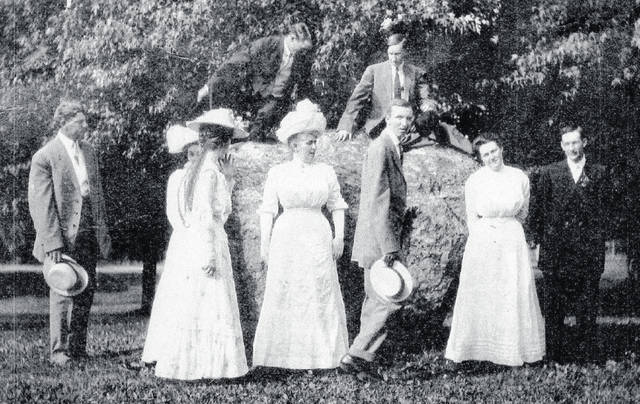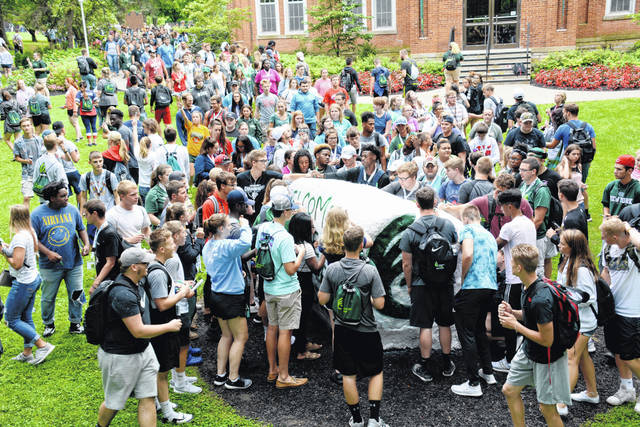

WILMINGTON — The Campus Rock at Wilmington College has been the subject of myth since it was placed in front of College Hall some 114 years ago this spring.
Many of these legends have been dispelled over the years, starting with the most incredulous one of all — that the massive boulder is merely a small stone covered in thousands of layers of paint.
Indeed, there are others. A team of horses did not pull the boulder on a farm sled over snow-covered roads as popularly believed and reported through the years.
Rather, a more 20th century brand of horsepower accomplished the feat. Also, the often-controversial act of painting the Rock did not start in the radical 1960s – indeed, it was initiated only hours after the Rock’s arrival on campus at the turn of the century.
Here’s the story.
In the spring of 1906, the core group of Leo McCoy, Russell D. Jay, Clayton Terrell undertook one of the most legendary exploits by students in Wilmington College history.
The seed for the deed was supposedly planted during a class picnic earlier that spring on the grounds of the Clinton County Infirmary on Fife Ave. Allegedly, the ambitious young men spotted the boulder there and devised a plan to transport it nearly a mile to campus and present it to their alma mater as the 1906 senior class gift.
While the multi-ton, metamorphosed granite with red garnets had last traveled some tens of thousands of years ago as part of the Wisconsin glacier, a handful of WC students planned to move the boulder over a weekend the distance it took hundreds or thousands of years for the Ice Age to relocate.
“We realized the Rock was heavy,” Jay said in reliving the experience some 46 years after the event in a letter he wrote in 1952 to Elsie McCoy, Leo McCoy’s sister.
The first day, the fellows dug with spades and shovels alongside and underneath the submerged rock deep enough in order to place house moving jacks. Those facilitated lifting the boulder high enough to put it on moving trucks.
“It has always been a wonder to me how we boys got that Rock lifted up and it did not fall on us and cripple us for life,” he noted.
Jay said the next day the young men secured “the largest steam threshing engine we could find” to pull the Rock-laden trucks along the mile trek west to campus.
“It got along fairly well as long as the road was level, but when there was a little uphill to pull, we had to figure out a different hitch,” he said.
“So, instead of a direct pull, we had to run the large rope or cable through a pulley, attaching one end of the cable to the base of a telephone pole some 50 feet ahead,” Jay recalled. “Then the engine attached to the other end pulled the cable through the pulley and in this way was able to move the Rock 40 feet up the road.”
This tedious process was repeated numerous times until they reached the summit of the incline.
“It was just about sundown when we got it to campus,” Jay said.
Needless to say, the spectacle of these seniors arriving at the front lawn of College Hall with the boulder in tow drew a crowd of onlookers – a group that included several with mischief on their minds.
McCoy’s daughter, Gertrude McCoy Workman, WC Class of ’35, recalled her father telling the story of how the excitement of their accomplishment suddenly turned to fury – but only momentarily.
“After the exhausting move, they were shocked early the next morning to find that someone had whitewashed the Rock completely,” Workman said. “But, not to be outdone, they promptly collected brushes and scoured The Rock back to its beautiful pink granite.”
Several members of the junior class were rumored to have been complicit in the crime and, in an attempt to prevent a repeat performance, a number of seniors took shifts guarding the Rock at night in the days before its dedication as a memorial to the Class of 1906.
“I was one who spent at least parts of two nights along with some other members of the class lying or sitting out on the campus watching or guarding the Rock from getting a paint job or other unnecessary attention from the juniors of that year,” Jay said.
Apparently, their vigilance paid off as the Rock remained free from paint until the late 1960s when it was utilized as everything from a political billboard to an artist’s canvas. In 1987, the Rock was sandblasted and cleansed of paint for a rededication ceremony, which some College officials hoped would usher in a new era of not painting the Rock.
Less than a week later, it was entombed in paint again and has remained so ever since. In 1996, a new tradition was started in which freshmen, as part of their New Student Orientation program, sign the Rock in a ceremony symbolizing the arrival of the newest members of the campus community. Around 2010, the practice came full circle with soon-to-be graduates, in essence, signing out following their Baccalaureate ceremony on the eve of Commencement.
Bill Channel, WC Class of ’41, vividly remembers the Rock from the time he was a youngster.
“As a child, I loved sitting and leaning against the Rock and feeling its coolness on my back while I waited for my mother (Edith Channel, a home economics faculty member),” Channel said. “My father would put me up on the Rock and I would pretend I was riding an elephant.”
He also remembers the Rock as a favorite meeting place during his College days.
“I was intrigued by the beauty of the stone itself,” Channel said, noting legendary WC professor Oscar F. Boyd took his geology class to the Rock and helped them identify the feldspar, quartz, hornblende and sparkling mica.
On Aug. 19, 1967, what sparkled were a blushing bride’s eyes and diamond ring as Dennis ’65 and Barbara Magley were married alongside what from the 1940s through 60s was known as “The Kissing Rock.” The legend held that a couple that kissed each other for the first time in the shadow of the Rock would someday marry.
“One of our first kisses was at The Kissing Rock and we were married there,” Magley said, noting they always envisioned an outdoor wedding and the campus was a place chock full of fond memories for him and his Wilmington native fiancé.
“There used to be a limb from an oak tree that arched over the Rock – we got married under the arch and the Carillon played,” he added.
Channel, Magley and thousands of other WC alumni have life-long memories of the Rock, but, for Channel, those pleasant memories of his youth were tainted by thought of the Rock’s hundreds of layers of paint.
“Now it’s just a sign board for ugly graffiti,” he said. “I’m sure Leo McCoy would be saddened to see what has happened to his beautiful boulder.”
Perhaps, not.
In Jay’s written narrative, the Rock itself seems more symbolic than substantive. Indeed, what would possess several 22-year-olds to spend a weekend transporting what has been described in various accounts as a three-to-30-ton boulder? This was long before the advent of easily accessible, heavy-duty trucks and massively powerful front-end loaders.
The Class of 1935, which included McCoy’s children, Gertrude and Elmore McCoy, answered that question by installing a plaque dedicating the Rock to “the spirit of youth.” In reminiscing, Jay concurred.
“We know now that youth will tackle most any job,” he said, “since they don’t know it can’t be done — and they often succeed.”
Jay described the Rock as “a tombstone or a milestone to the past,” representing the life he and his classmates had lived through their graduation in 1906.
“We were each entering a new phase of real undertaking and accomplishment,” he said. “(the Rock and subsequent Commencement) marked the end of one phase of my life and the beginning of a series of others. We owe a lot to what we got at Wilmington College.”
When the Rock was formally presented to the College, the Class of 1906 described it as a memorial that symbolized their “unchangeableness, genuineness, and stability.”
At the class’ 50th reunion in 1956, Susanne Terrell said their alma mater and the Class of 1906’s gift had a lot in common.
“Both are permanent and lasting,” she said. “Though students and faculty come and go, the College and the Rock go on. The Rock may not house or educate students; however, it is part of Wilmington College’s history.”



